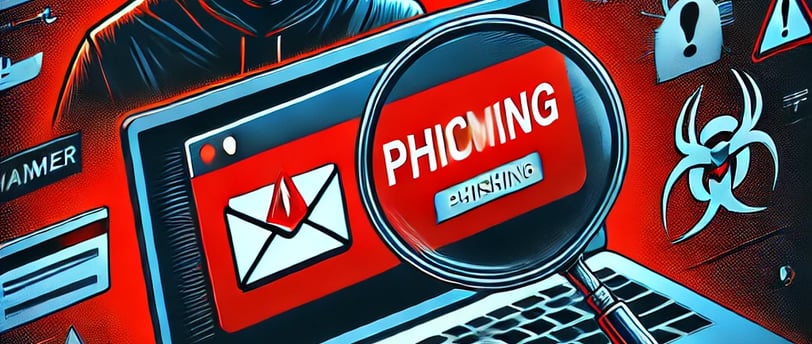Malicious Emails
Learn to differentiate between genuine messages and phishing attempts that try to steal your passwords and data


How to Differentiate Between Genuine Messages and Phishing to Protect Your Information
Malicious emails, also known as phishing, are one of the most common tools used by cybercriminals to deceive users and steal sensitive information such as passwords, banking data, and credit card numbers. Often disguised as legitimate communications, these emails aim to emotionally manipulate the victim into taking harmful actions, such as clicking dangerous links or downloading infected files.
In this article, we’ll explore how malicious emails work, identify the main signs of fraud, and learn effective strategies to protect yourself.
What is Phishing?
Phishing is a digital fraud technique where the criminal impersonates a trusted entity, such as a bank, online store, streaming service, or even a government agency, to deceive the recipient. The intent is to trick them into:
Providing sensitive information, such as login credentials.
Making payments to fraudulent accounts.
Downloading malware that compromises their device.
Common Types of Malicious Emails
Cybercriminals use different approaches to target their victims. Here are some of the most common types:
1. Fake Bank Notifications
Emails claiming suspicious activity on your bank account or requesting you to update your details.
Example subject line:
“Security Alert: Your Account Will Be Blocked”
2. Fake Promotions or Offers
Tempting offers asking you to click a link to claim discounts or prizes.
Example subject line:
“Congratulations! You Won an iPhone 15!”
3. Tech Support Scams
Messages pretending to be from tech support, asking for remote access to your computer or passwords.
Example subject line:
“Issues Detected on Your Computer – Action Required!”
4. Fake Invoices or Bills
Emails with tampered invoices or links to supposed bills redirecting you to fraudulent sites.
Example subject line:
“Outstanding Invoice – Pay Now to Avoid Penalties”
5. Threats of Viruses or Data Exposure
Emails claiming your device was hacked or threatening to release compromising information unless you pay a ransom.
Example subject line:
“Your Data Has Been Stolen – Pay Now to Recover It”
Warning Signs in Malicious Emails
Learning to identify fraudulent emails is the first step to avoiding scams. Here are the main warning signs:
1. Spelling and Grammar Errors
While scammers are becoming more sophisticated, many malicious emails still have noticeable grammar, spelling, or translation errors.
2. Suspicious Sender
Check the sender’s email address. Criminals often use addresses that mimic legitimate ones but with slight variations, such as:
Legitimate: support@yourbank.com
Fake: support@your-bank.com
3. Dubious Links
Before clicking any link, hover over it to check the full address. If the domain looks strange or doesn’t match the entity, it’s likely fraudulent.
4. Urgent Tone or Threats
Messages pressuring you to act quickly, such as "Your account will be deactivated in 24 hours" or "Pay now to avoid penalties," are suspicious.
5. Requests for Personal Information
Legitimate companies never ask for passwords, credit card numbers, or banking details via email.
Strategies to Differentiate Genuine Emails from Fake Ones
Even as scams grow more sophisticated, these strategies can help you identify a message’s authenticity:
1. Verify the Email’s Source
Confirm the sender’s address.
Compare it with legitimate emails you’ve received from the same company.
2. Be Wary of Tempting Offers
If something seems too good to be true, it probably is a scam. Legitimate promotions are usually advertised on official websites, not solely via email.
3. Check the Official Website
Never click directly on links in a suspicious email. Instead, type the address into your browser or use saved bookmarks.
4. Contact the Company Directly
If you receive an email that appears to be from a bank or service you use, contact them directly to verify its legitimacy.
How to Protect Your Information from Malicious Emails
Prevention is always better than a cure. Here are some practical tips to safeguard yourself:
1. Enable Two-Factor Authentication (2FA)
Activate 2FA whenever possible. This way, even if someone steals your password, they won’t be able to access your account without the second authentication factor.
2. Keep Your Software Updated
Regularly update your operating system, browsers, and antivirus software to protect against known vulnerabilities.
3. Use Email Filters
Email services like Gmail and Outlook have filters that identify and block suspicious messages. Make sure these options are enabled.
4. Avoid Downloading Files from Unknown Sources
Refrain from downloading attachments in suspicious emails. Malicious files may contain viruses or ransomware that compromise your device.
What to Do If You Fall for a Scam
Even with all precautions, it’s possible to fall for a scam. If this happens, follow these steps immediately:
1. Change Passwords
Immediately update the passwords for all affected accounts. Make sure to choose strong, unique passwords.
2. Notify the Involved Institution
If the compromised data involves a bank or financial service, inform the institution so they can monitor your account and prevent unauthorized transactions.
3. Monitor Transactions
Regularly check your banking transactions for suspicious activity.
4. File a Police Report
Your data could be used to commit other crimes. Filing a police report creates an official record of the incident.
Education and Awareness: The Best Defense
The fight against malicious emails relies on user awareness. Share this knowledge with friends, family, and colleagues to help reduce the impact of this type of scam.
Conclusion
Malicious emails pose a significant risk to digital security, but with the right tools and strategies, they can be avoided. Remember to be cautious, always verify the origin of messages, and never share sensitive information via email. When in doubt, breathe, think, and avoid acting impulsively.
Security
Protect your family from online scams daily.
© 2024. All rights reserved.
